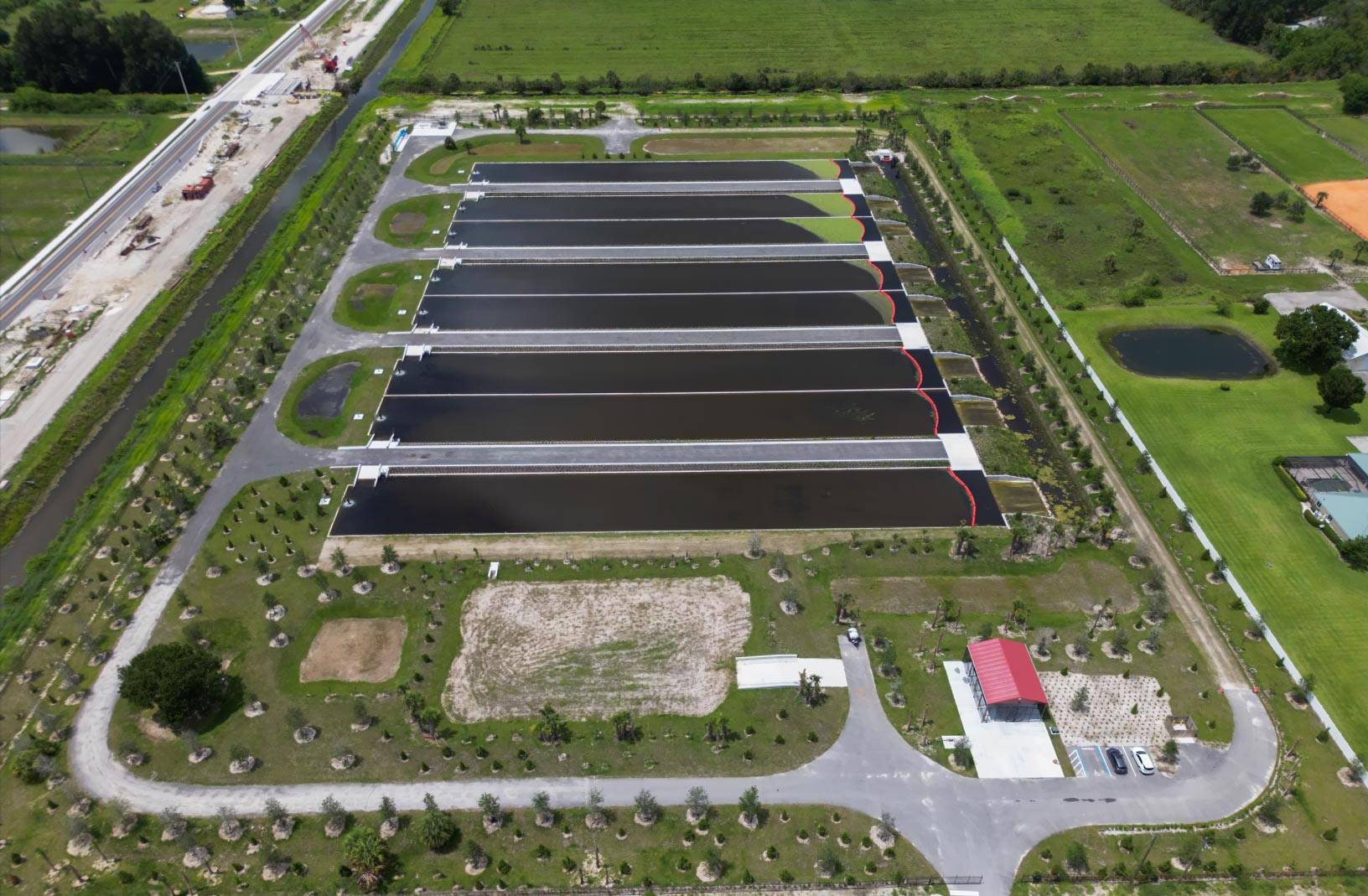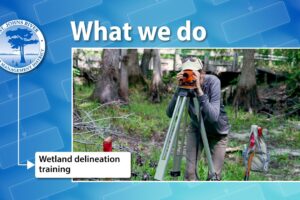Indian River County opens plant-powered stormwater cleanup project
July 20, 2023
If you came to Moorhen Marsh during an early stage of construction, you’d be forgiven for thinking it was destined to be an amusement park: water fills a series of shallow concrete troughs called raceways; at one end, there’s a gentle waterfall, and in between each trough palm trees wave in the breeze. But rather than kids bobbing in rubber tubes, waterlettuce floats along, soaking up the Florida sun.
Moorhen Marsh is not a water park, nor is it an aquaculture facility. The Moorhen Marsh Low Energy Aquatic Plant System (LEAPS) is a stormwater treatment facility. The treatment method relies only on plants to improve the water quality before it flows into the Indian River Lagoon. “It’s a really innovative project and very beneficial to the lagoon,” says Melisa Diolosa, a project manager with the St. Johns River Water Management District. Indian River County was the brains behind the state-of-the-art project, and the District partially funded the project through the Indian River Lagoon Water Quality Grant Program.
The stormwater that will be treated comes from the North Relief Canal, which drains water from 6,300 acres of Indian River County. This and other canals in the region provides flood control. As stormwater runoff drains into the canal, it carries excess fertilizers from lawns and agriculture, as well as pet waste and yard debris picked up from the surface of the land. These all contribute to nutrient pollution, and in Indian River County, this pollution winds up in the Indian River Lagoon where it threatens the most diverse estuary in North America.
The Moorhen Marsh LEAPS facility pulls in 10 million gallons of water per day from the canal and diverts it to the Moorhen Marsh site to be treated. First, the canal water goes through a screen to remove debris and keep wildlife out, then water slowly flows through a series of troughs. Waterlettuce floating on top takes in nitrogen and phosphorus from the water. The floating plants convert the excess nutrients from the water into more plant material, leaves and roots. Then, before going back into the canal, the water goes over a gently sloping waterfall that adds more oxygen to the water.
We like it because we’re getting measurable amounts of nutrients out of the system entirely. … The facility improves water quality overall
Periodically, county staff raise weirs at the end of one of the raceways and harvest the solar-powered pollution processors (aka waterlettuce), dry it, and haul it to the landfill, complete with the excess nitrogen and phosphorus.
“We like it because we’re getting measurable amounts of nutrients out of the system entirely,” says Eric Charest, natural resource manager with Indian River County. Based on samples of plant tissue, they know how much nitrogen and phosphorus are removed in each ton of waterlettuce. Indian River County engineers estimate that they will be able to pull 4,854 lbs/yr of nitrogen and 785 lbs/yr of phosphorus from the water before reaching the lagoon. That’s the equivalent amount of nitrogen contained in 970 bags of 10-10-10 fertilizer, enough to feed just over120 football fields worth of turf grass. As for phosphorus, the amount removed would be equivalent to 157 bags of fertilizer, enough to feed 54.5 football fields of turf grass at the maximum rates recommended for Florida.
“There are other benefits as well,” says Charest. “The gravity-fed slow-flowing system allows solids to fall out, and the plants and the waterfall action supersaturate the water with dissolved oxygen. The facility improves water quality overall.”
It’s a one-of-a-kind stormwater treatment facility designed by an engineer with a penchant for thinking out of the box. Keith McCully, now retired, designed this facility. Throughout his career, he engineered stormwater systems that take advantage of surrounding conditions.
Take, for example, the waterlettuce that’s the workhorse of the facility. Waterlettuce is an invasive plant that clogs Florida’s waterways. This floating plant doubles in density every few weeks in the canal. The sizable floating mats clog canals and overwhelm flood control structures, in addition to restricting wildlife from their habitat.
McCully took a lemons/lemonade approach at the Moorhen Marsh LEAPS facility, using the constantly replenishing supply of waterlettuce as a tool to absorb nutrient pollution. Once they have filled the trough, the plants (and nutrients stored in their tissues) are removed. The invasive plants are contained until they’ve done their job, then removed so they won’t contribute to problems elsewhere.
The surrounding wildlife — from pollinators to alligators — is accommodated in the design. Like many of the projects McCully designed, Moorhen Marsh incorporates native plants for habitat. Should an alligator wander into the troughs, the slope is designed so it can walk back out. The pump that draws water from the canal excludes fish and turtles, and should a turtle find itself among the debris, ramps allow it to climb out.
“McCully designed these facilities to work for the animals and the people,” says Laura Yonkers, a stormwater engineer with Indian River County. “He would think about every species and their needs in his designs.”
The facility is also designed to fluctuate and adapt to changing water levels in the canal and nutrient levels in the water. Construction on the 18-acre facility was completed in March 2023, and the facility is now open and operational.






